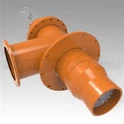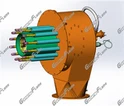The working conditions of the valve are very bad. First of all, the valve is directly in contact with the high-temperature gas, which is severely heated, and the heat dissipation is difficult, so the valve temperature is high. Secondly, the valve is subjected to the action of the gas force and the valve spring force, and the inertial force of the moving member of the valve train causes the valve to be impacted when it is seated. Third, the valve opens and closes at a very high speed under poor lubrication conditions and reciprocates at high speed in the valve guide. In addition, the valve is corroded by contact with corrosive gases in the high temperature gas.
The function of the valve guide is to guide the movement of the valve, to ensure that the valve reciprocates linearly, so that the valve and the valve seat or the valve seat can be properly fitted. In addition, the heat received by the valve stem is partially transmitted to the cylinder head. The valve guide has a high operating temperature and poor lubrication conditions, and the oil splashed by the gas distribution mechanism to lubricate the valve stem and the valve guide hole. The valve guide is made of gray cast iron, ductile iron or iron-based powder metallurgy. After pressing the valve guide into the valve guide seat hole on the cylinder head with a certain interference, the valve guide hole is reamed to ensure the correct matching clearance between the valve guide and the valve stem.
The function of the valve spring is to ensure that the valve seat can be closely fitted with the valve seat or the valve seat when the valve is closed, and overcome the inertial force generated by the valve train when the valve is opened, so that the transmission member is always controlled by the cam without being separated from each other.
The valve spring is generally an equal pitch cylindrical coil spring. The valve spring resonates when the operating frequency of the valve spring is equal to or integral with its inherent vibration frequency. Resonance will cause the timing of the valve to be destroyed, causing the valve to rebound and impact, and even breaking the spring. To prevent resonance from occurring, the following structural measures can be taken:
1) Adopting double-valve springs On the diesel engine and high-performance gasoline engine, it is widely used to install two inner and outer springs with different diameters and opposite directions for each valve. Since the natural frequencies of the two springs are different, when one spring resonates, the other spring can dampen the damping effect. The double valve spring can be used to reduce the height of the valve spring, and when one spring is broken, the other spring can still maintain the valve operation. The spring is turned in the opposite direction to prevent the broken spring ring from snapping into the other spring ring to make it inoperable or damaged.
2) Variable pitch valve springs Some high performance gasoline engines use variable pitch single valve springs. The natural frequency of the variable pitch spring is not constant, so that resonance can be avoided.
3) Conical valve spring The stiffness and natural vibration frequency of the conical valve spring vary along the axis of the spring, thus eliminating the possibility of resonance.







